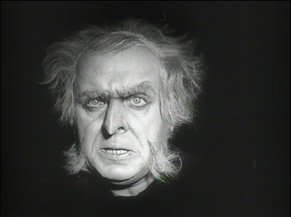|
|
Chapter Two:
|

|
In the psychiatric ward, Mabuse is silent and catatonic after a fashion, his only effort directed toward a near-constant stream of scribbling. In the room where Mabuse’s underlings receive their orders to kill and cause mayhem, instructions are issued – Wizard of Oz-like - by a shadowy figure seated behind a curtain. In a dramatic unveiling in the film’s second half, it is revealed that the “person” is a cardboard cutout and the voice emanates as a recording from a phonograph. The one moment that comes closest to achieving a body and voice unity - when Mabuse’s spirit appears to enter and control Dr. Baum - features Mabuse’s features distorted by a grotesque death mask.New at BOP: Share & Save
![]() Tweet
Tweet
![]() Print this column
Print this column
While Dr. Mabuse the Gambler is a rambling and not entirely successful epic, it places a premium on a dense, sprawling narrative that nonetheless remains comprehensible and on characters that work within, instead of being controlled by the plot. Structured with 12 acts that unfold over two distinct parts (full movies actually, running 155 minutes and 115 minutes in the “definitive” version I viewed), its mammoth running time gives it the feel of a serial with any number of cliffhangers. It also concludes with a wrap-up built around very definitive moralistic underpinnings.
The Testament of Dr. Mabuse is more of a nightmare that unfolds with the logic that can only punctuate dreams or their dark mirrors. Holding this logic up to the light of the day is an act in futility. An attempt to accurately synopsize the plot, as you may have gathered from some of my thoughts above, can only lead to frustration and ridicule. Questions such as - How did Mabuse’s voice get recorded? Do any of the underlings know that their boss isn’t really “all there?” What happens to Hofmeister to drive him insane? - aren’t so much raised as slightly elevated and left dangling. Lang plows through them all to create innumerable sequences of “pure cinema - moments that exist on their own and carry the picture securely over any plot-based objections.
|
Advertisement |
The opening five minutes contain no dialogue and no musical score of any kind, only the ambient, increasingly unnerving sounds of industrial pipes and machine noise as an undercover policeman attempts to elude capture and avoid detection inside a factory. The sounds are so grating (and unexpected) that my first thought was my speakers were on the fritz (unintentional pun, sorry.)
Lang could have easily begun the picture with the act of narrative that immediately follows: Hofmeister calling his former boss, Inspector Lohman, and frantically attempting to convince him that he now knows the name of the man behind the nefarious illegal activities in their city. As mentioned previously, the fact that Hofmeister is deigning to announce the Name that Dare not be Spoken doesn’t bode well for his future safety or sanity.
By opting for so disorienting and unsettling a prelude, Lang immediately establishes the tone of unease and uncertainty that pervades the rest of the film. Thus, even when the narrative becomes more conventional at times, working in crime drama stand-bys like the felon angling for redemption, a possibly ill-fated love affair, narrow escapes from death and betrayal, and a breathless auto chase in the dead of night, Lang finds a way to use sound and/or image to keep the audience off balance.

|
|
|

|
Friday, November 1, 2024
© 2024 Box Office Prophets, a division of One Of Us, Inc.

